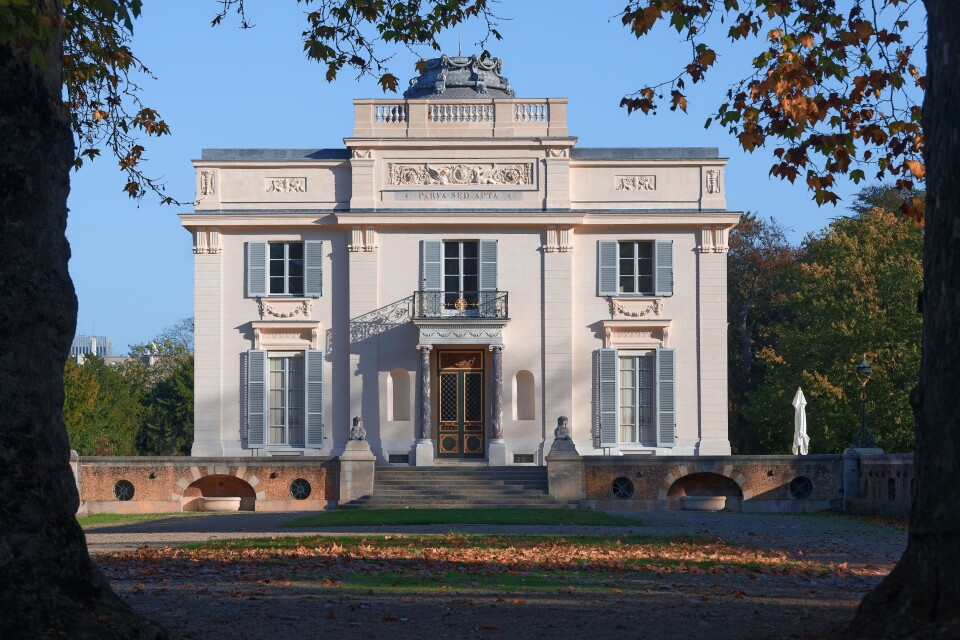-
Owners of French mill seek help tracing history
'We are looking for old photographs from before it closed,' say couple who restored the building
-
One of the most notorious meals in the history of French gastronomy
How hard times inspired an outrageous festive feast in 1870
-
Brouage: inland fortified French village was once a major European salt port
Some 400,000 tourists visit every year - many of whom are Canadian
Princely French residence saved by Englishmen
Charlotte Vignon introduces a new book charting the history of Château de Bagatelle, Parisian getaway villa of kings and royal family members

The book's author, Nicolas Cattelain, begins this history in the early eighteenth century, when a certain Lucie Félicité de Noailles owned a little home – also called Bagatelle – on the spot of the count’s future pleasure house.
Cattelain fills in and sometimes corrects details of the ups and downs of the premises in the days of the comte d’Artois, but above all he continues the tale into the nineteenth and twentieth centuries.
Cattelain informs us that the count’s “folly” was not only a paean to eighteenth-century France but that it also incarnated the nineteenth century through a series of famous owners.
Read more: Man leaves fortune to French village that saved Jews in WWII
A historical tapestry of royalty and architecture
Following the comte d’Artois, Napoleon I and Empress Marie-Louise briefly occupied the pavilion (where their young son, styled the King of Rome, would play), before becoming the property of the duc and duchesse de Berry, where it served as a cradle for another royal prince, the duc de Bordeaux.
In 1835, Bagatelle was bought by the marquess of Hertford, who bequeathed it to Richard Wallace in 1870, after which it was purchased by the City of Paris in 1905. This little neoclassical building turns out to be not a perfect embodiment of the Louis-XVI style but rather a challenge to the history of French art and tastes.
Right from the start, Bagatelle’s architecture was surprising in terms of plan and façade, having been inspired by Palladian-revival villas discovered by the English architect William Chambers during a trip to Italy around 1750.
Yet it was not surprising, according to Cattelain, that the pavilion’s architect, François-Joseph Bélanger, had never been to Italy (unlike most artists and architects of his generation), since he travelled regularly to England, where he saw the neoclassical works of Chambers and Robert Adams.
The irony, as stressed by the author, was that the “English” quality sought by Bélanger and the young comte d’Artois – the most Anglophile prince at the French court – was effaced in the 1860s by an Englishman, the rich collector Lord Hertford, who decided to make Bagatelle more ‘French’ by giving it a façade of proportions typical of the Louis-XVI style of 1770–80.
That was when the role of the pavilion also changed; conceived in the eighteenth century as a pleasure house where people rarely spent the night, it thereafter became a regular residence for Hertford and his illegitimate son, Sir Richard Wallace.
An artful English influence
From 1835 to 1905 the story of Bagatelle was closely tied to the fate of the Seymour-Conway family, marquesses of Hertford. It is the sad tale of an aristocratic line that ended in dissoluteness and isolation after just a few generations, yet it is also the wonderful genesis of the creation of one of the most important and perhaps largest collections of art ever to be assembled in the nineteenth century.
Read more:Black US D-Day veteran awarded France’s highest honour aged 100
This “English” chapter in Bagatelle’s history can be traced back to the unexpected and intimate relationship that the Seymour-Conways built with France, which made the 4th Marquess and his heir, Richard Wallace, true Frenchmen by adoption. Lord Hertford bought Bagatelle on September 22, 1835, and spent much of his life there until he passed away on August 25, 1870.
He died in the bedroom of the comte d’Artois overlooking the main courtyard and Seine, exactly one week after Napoleon III lost the battle of Sedan, bringing down the Second Empire.
Hertford’s illegitimate son, private secretary, and principal legatee, Sir Richard Wallace, died twenty years later in the same bed in that same bedroom, owner of a vast fortune and a henceforth famous art collection, part of which would become the Wallace Collection in London in 1906. Two Englishmen in France, two lives spent between London, Paris, and Bagatelle: lives full of turmoil, adventure, tragedy, and beauty.
Back to neoclassical
The comte d’Artois’s little pleasure house, so loved by the duc de Berry, whose children grew up there, had been neglected ever since the Bourbons emigrated and was, unfortunately, in poor condition. Thomas Raikes, a banker, dandy, and famous diarist, was passing through Paris when his friend Hertford invited him to have a look at the new purchase. Raikes described the visit in his journal on March 1, 1836:
"I went this morning with Yarmouth [i.e., Hertford] to look at his new purchase of Bagatelle, where he is repairing and improving the whole domain. He is building a range of greenhouses on the model of those at Chiswick and adding to the plantations. There is a large steam-engine which supplies the house, the offices, the ponds and the cascade with water from the Seine...
The dry rot has unfortunately made its way into the house, and it has become necessary to lay down new floorings in all the rooms, ... which is the more to be regretted as it must injure the beautiful painted ceilings of the principal apartments.
We detected some remains of the fresco paintings in the boudoir, which were done by the order of the comte d’Artois, and form a great contrast to the present devout habits of Charles X. When completely restored..., it will be the most beautiful fairy retreat in France, at only a quarter of an hour’s drive from the capital.”
Apart from this rare account, we remain unaware of the exact extent of work done after Hertford bought Bagatelle. Whatever the case, that work represented the start of a long series of changes that would significantly affect the appearance of the premises.
Historical breakdown
- Sometime during the 1860s – probably 1864 – Hertford asked architect Léon de Sanges to raise the height of the château, thereby making the upper floor more comfortable; this resulted in a significant alteration of the courtyard façade.
- During the same period, de Sanges also erected new, larger stables on the other side of the main entrance to the grounds. These buildings, which can still be seen today, were done in the vernacular, red-brick style, apparently to match the “chalet style” used by Davioud for the entrance to the Bois de Boulogne. The water pump, which also survives, was also rebuilt in a “mixed” revival style of Louis-XIII inspiration.
- In 1871, Richard Wallace, having just inherited the property from Lord Hertford, built the rococo Louis-XV style pavilion that still stands at the entrance to the grounds.
- Finally, in 1872–73, Wallace demolished the Pages’ Pavilion, which had been damaged during the events of the Paris Commune, and replaced it by two small guards’ pavilions flanking the lane leading toward the château.
To the right of this lane, a new building, dubbed Trianon, was built in a Gabriel-revival style to harmonise with the château’s new façade. The domestic staff formerly housed in the Pages’ Pavilion were moved to quarters underneath the main terrace opposite the Trianon, overlooking what is today “la route de Sèvres à Neuilly.”
Paradoxically, it was the English owners of Bagatelle who stripped the comte d’Artois’s country retreat of its typically British Palladian appearance, replacing it with a French neoclassical one. It is perfectly understandable that Lord Hertford should want a more comfortable, modern home where he could really live.
Related articles
Grandfather inspires Briton’s epic French cycling challenge
French man finds bracelet of American WWII soldier in a field
Career change in France: ‘I never tire of talking about World War Two’
























